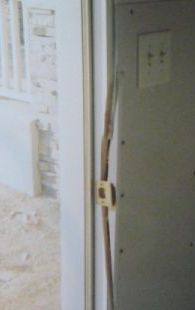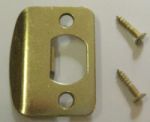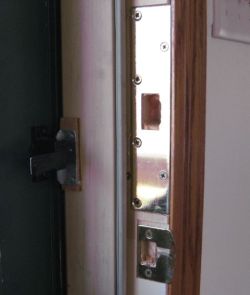
Home Security Tips
Have you noticed? The world is not getting any
safer. In fact, in many parts of the U.S., it is getting downright
dangerous. To better protect your home and family, you must
take all practical steps for protecting your home and family.
This section is devoted providing the security-conscious homeowner with practical tips and suggestions based on my experiences (of many years) as the owner of a security company specializing in locks and alarm systems. I hope you find value in them.
Protecting Your Home With Deadbolts
 The picture at left is typical of what a
door jamb looks like after a door has been kicked in. The customer
had deadbolts on the front door plus the door between the house
and garage but the vulnerable garage service door had just a
key-in-knob (KIK) lock installed.
The picture at left is typical of what a
door jamb looks like after a door has been kicked in. The customer
had deadbolts on the front door plus the door between the house
and garage but the vulnerable garage service door had just a
key-in-knob (KIK) lock installed.
In addition to the spring-loaded latch on the KIK lock being just
5/8" in  length, the strike plate and screws (3/4" in length)
holding the plate to the jamb (at right) are minimal security and
are no match for a well placed kick.
length, the strike plate and screws (3/4" in length)
holding the plate to the jamb (at right) are minimal security and
are no match for a well placed kick.
You need quality deadbolts with a 1' throw and heavy-duty strike
plates on all exterior doors if you are serious about preventing
an easy break-in via a kicked in door. Sometimes just the sight of
deadbolts on doors is enough to cause the bad guys to find an
easier mark.
Strike Plates Basics - Part 1
Once you have good quality deadbolts installed on all of your exterior doors, the next step is to make sure the strike plates that are installed will withstand break-in attempts.
In the picture below, you will see a variety of strike plates -
some good, some not so good. Going from left to right, the first
plate was included with a U.S. made  deadbolt of decent quality but they
cheaped out on this inferior 2 1/4" by 1" strike plate.
deadbolt of decent quality but they
cheaped out on this inferior 2 1/4" by 1" strike plate.
The next strike plate was also included with a U.S. manufactured deadbolt of even better quality than the first. Even though it is a little larger (2 3/4" by 1 1/8") and was furnished with 3" screws, it still isn't tough enough against a good kick or broad shoulder. If you have strike plates like these first two, replace them with better ones.
The strike plate in the middle is a decent plate in that it is bigger (3 5/8" by 1 1/4"), thicker and comes with 2 1/2" screws. This plate was included with a good quality deadbolt of a U.S. lock manufacturer. I would install a plate like this (at no extra charge) if the deadbolt selected by the customer came with an "weak" plate and the customer did not want to purchase a heavy duty plate.
The next plate is not one that was included with a deadbolt but is purchased separately. It is 4 7/8" by 1 1/4" with long screws used in the top and bottom centered holes and shorter screws used in the side holes. If using a plate with centered holes, make sure the long screws are going into the wood framing and not just sheetrock (or half wood and half sheetrock).
The last plate in the above picture is a heavy duty  strike plate and one I would recommend
to every deadbolt customer. This plate is 7 3/4" by 1 5/8" and
comes with four 3" screws, which go deep into the door framing,
and two shorter screws used to "position" the strike plate. Plates
like this are not expensive and well worth the investment. The
picture on the right shows what the plate looks like installed.
strike plate and one I would recommend
to every deadbolt customer. This plate is 7 3/4" by 1 5/8" and
comes with four 3" screws, which go deep into the door framing,
and two shorter screws used to "position" the strike plate. Plates
like this are not expensive and well worth the investment. The
picture on the right shows what the plate looks like installed.
You may notice part of the bolt hole has been filed away. The deadbolt was hitting the edge of the plate so I filed away that portion so the bolt would go in smoothly. Using a tube of old lipstick made a great marker as to what to file.
Disclaimer: I have made every reasonable effort to produce
Home Security Tips based on my research and experiences. However,
I make no representation or warranties of any kind with regard to
its completeness, accuracy or suitability for any specific
situation or purpose. See our Warranty Policy for more info.